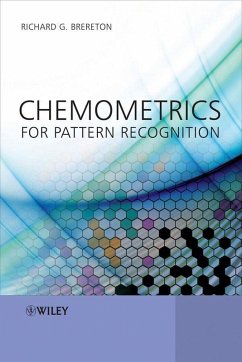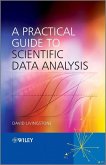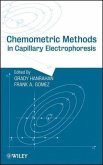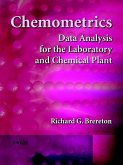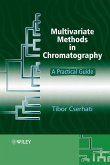Chemometrics for Pattern Recognition (eBook, PDF)


Alle Infos zum eBook verschenken

Chemometrics for Pattern Recognition (eBook, PDF)
- Format: PDF
- Merkliste
- Auf die Merkliste
- Bewerten Bewerten
- Teilen
- Produkt teilen
- Produkterinnerung
- Produkterinnerung

Hier können Sie sich einloggen

Bitte loggen Sie sich zunächst in Ihr Kundenkonto ein oder registrieren Sie sich bei bücher.de, um das eBook-Abo tolino select nutzen zu können.
Over the past decade, pattern recognition has been one of the fastest growth points in chemometrics. This has been catalysed by the increase in capabilities of automated instruments such as LCMS, GCMS, and NMR, to name a few, to obtain large quantities of data, and, in parallel, the significant growth in applications especially in biomedical analytical chemical measurements of extracts from humans and animals, together with the increased capabilities of desktop computing. The interpretation of such multivariate datasets has required the application and development of new chemometric techniques…mehr
- Geräte: PC
- mit Kopierschutz
- eBook Hilfe
- Größe: 37.25MB
![A Practical Guide to Scientific Data Analysis (eBook, PDF) A Practical Guide to Scientific Data Analysis (eBook, PDF)]() David N. LivingstoneA Practical Guide to Scientific Data Analysis (eBook, PDF)69,99 €
David N. LivingstoneA Practical Guide to Scientific Data Analysis (eBook, PDF)69,99 €![Chemometric Methods in Capillary Electrophoresis (eBook, PDF) Chemometric Methods in Capillary Electrophoresis (eBook, PDF)]() Chemometric Methods in Capillary Electrophoresis (eBook, PDF)123,99 €
Chemometric Methods in Capillary Electrophoresis (eBook, PDF)123,99 €![Chemometrics (eBook, PDF) Chemometrics (eBook, PDF)]() Richard G. BreretonChemometrics (eBook, PDF)83,99 €
Richard G. BreretonChemometrics (eBook, PDF)83,99 €![Multivariate Methods in Chromatography (eBook, PDF) Multivariate Methods in Chromatography (eBook, PDF)]() Tibor CserhatiMultivariate Methods in Chromatography (eBook, PDF)152,99 €
Tibor CserhatiMultivariate Methods in Chromatography (eBook, PDF)152,99 €![Automation in Proteomics and Genomics (eBook, PDF) Automation in Proteomics and Genomics (eBook, PDF)]() Gil AlterovitzAutomation in Proteomics and Genomics (eBook, PDF)125,99 €
Gil AlterovitzAutomation in Proteomics and Genomics (eBook, PDF)125,99 €![Multi-way Analysis (eBook, PDF) Multi-way Analysis (eBook, PDF)]() Age K. SmildeMulti-way Analysis (eBook, PDF)160,99 €
Age K. SmildeMulti-way Analysis (eBook, PDF)160,99 €![Chemometrics in Excel (eBook, PDF) Chemometrics in Excel (eBook, PDF)]() Alexey L. PomerantsevChemometrics in Excel (eBook, PDF)81,99 €
Alexey L. PomerantsevChemometrics in Excel (eBook, PDF)81,99 €-
-
-
Dieser Download kann aus rechtlichen Gründen nur mit Rechnungsadresse in A, B, BG, CY, CZ, D, DK, EW, E, FIN, F, GR, HR, H, IRL, I, LT, L, LR, M, NL, PL, P, R, S, SLO, SK ausgeliefert werden.
- Produktdetails
- Verlag: John Wiley & Sons
- Seitenzahl: 522
- Erscheinungstermin: 1. Juli 2009
- Englisch
- ISBN-13: 9780470746479
- Artikelnr.: 37299040
- Verlag: John Wiley & Sons
- Seitenzahl: 522
- Erscheinungstermin: 1. Juli 2009
- Englisch
- ISBN-13: 9780470746479
- Artikelnr.: 37299040
1.2 About this Book. Bibliography. 2 Case Studies. 2.1 Introduction. 2.2
Datasets, Matrices and Vectors. 2.3 Case Study 1: Forensic Analysis of
Banknotes. 2.4 Case Study 2: Near Infrared Spectroscopic Analysis of Food.
2.5 Case Study 3: Thermal Analysis of Polymers. 2.6 Case Study 4:
Environmental Pollution using Headspace Mass Spectrometry. 2.7 Case Study
5: Human Sweat Analysed by Gas Chromatography Mass Spectrometry. 2.8 Case
Study 6: Liquid Chromatography Mass Spectrometry of Pharmaceutical Tablets.
2.9 Case Study 7: Atomic Spectroscopy for the Study of Hypertension. 2.10
Case Study 8: Metabolic Profiling of Mouse Urine by Gas Chromatography of
Urine Extracts. 2.11 Case Study 9: Nuclear Magnetic Resonance Spectroscopy
for Salival Analysis of the Effect of Mouthwash. 2.12 Case Study 10:
Simulations. 2.13 Case Study 11: Null Dataset. 2.14 Case Study 12: GCMS and
Microbiology of Mouse Scent Marks. Bibliography. 3 Exploratory Data
Analysis. 3.1 Introduction. 3.2 Principal Components Analysis. 3.2.1
Background. 3.2.2 Scores and Loadings. 3.2.3 Eigenvalues. 3.2.4 PCA
Algorithm. 3.2.5 Graphical Representation. 3.3 Dissimilarity Indices,
Principal Co-ordinates Analysis and Ranking. 3.3.1 Dissimilarity. 3.3.2
Principal Co-ordinates Analysis. 3.3.3 Ranking. 3.4 Self Organizing Maps.
3.4.1 Background. 3.4.2 SOM Algorithm. 3.4.3 Initialization. 3.4.4
Training. 3.4.5 Map Quality. 3.4.6 Visualization. Bibliography. 4
Preprocessing. 4.1 Introduction. 4.2 Data Scaling. 4.2.1 Transforming
Individual Elements. 4.2.2 Row Scaling. 4.2.3 Column Scaling. 4.3
Multivariate Methods of Data Reduction. 4.3.1 Largest Principal Components.
4.3.2 Discriminatory Principal Components. 4.3.3 Partial Least Squares
Discriminatory Analysis Scores. 4.4 Strategies for Data Preprocessing.
4.4.1 Flow Charts. 4.4.2 Level 1. 4.4.3 Level 2. 4.4.4 Level 3. 4.4.5 Level
4. Bibliography. 5 Two Class Classifiers. 5.1 Introduction. 5.1.1 Two Class
Classifiers. 5.1.2 Preprocessing. 5.1.3 Notation. 5.1.4 Autoprediction and
Class Boundaries. 5.2 Euclidean Distance to Centroids. 5.3 Linear
Discriminant Analysis. 5.4 Quadratic Discriminant Analysis. 5.5 Partial
Least Squares Discriminant Analysis. 5.5.1 PLS Method. 5.5.2 PLS Algorithm.
5.5.3 PLS-DA. 5.6 Learning Vector Quantization. 5.6.1 Voronoi Tesselation
and Codebooks. 5.6.2 LVQ1. 5.6.3 LVQ3. 5.6.4 LVQ Illustration and Summary
of Parameters. 5.7 Support Vector Machines. 5.7.1 Linear Learning Machines.
5.7.2 Kernels. 5.7.3 Controlling Complexity and Soft Margin SVMs. 5.7.4 SVM
Parameters. Bibliography. 6 One Class Classifiers. 6.1 Introduction. 6.2
Distance Based Classifiers. 6.3 PC Based Models and SIMCA. 6.4 Indicators
of Significance. 6.4.1 Gaussian Density Estimators and Chi-Squared. 6.4.2
Hotelling's T². 6.4.3 D-Statistic. 6.4.4 Q-Statistic or Squared Prediction
Error. 6.4.5 Visualization of D- and Q-Statistics for Disjoint PC Models.
6.4.6 Multivariate Normality and What to do if it Fails. 6.5 Support Vector
Data Description. 6.6 Summarizing One Class Classifiers. 6.6.1 Class
Membership Plots. 6.6.2 ROC Curves. Bibliography. 7 Multiclass Classifiers.
7.1 Introduction. 7.2 EDC, LDA and QDA. 7.3 LVQ. 7.4 PLS. 7.4.1 PLS2. 7.4.2
PLS1. 7.5 SVM. 7.6 One against One Decisions. Bibliography. 8 Validation
and Optimization. 8.1 Introduction. 8.1.1 Validation. 8.1.2 Optimization.
8.2 Classification Abilities, Contingency Tables and Related Concepts.
8.2.1 Two Class Classifiers. 8.2.2 Multiclass Classifiers. 8.2.3 One Class
Classifiers. 8.3 Validation. 8.3.1 Testing Models. 8.3.2 Test and Training
Sets. 8.3.3 Predictions. 8.3.4 Increasing the Number of Variables for the
Classifier. 8.4 Iterative Approaches for Validation. 8.4.1 Predictive
Ability, Model Stability, Classification by Majority Vote and Cross
Classification Rate. 8.4.2 Number of Iterations. 8.4.3 Test and Training
Set Boundaries. 8.5 Optimizing PLS Models. 8.5.1 Number of Components:
Cross-Validation and Bootstrap. 8.5.2 Thresholds and ROC Curves. 8.6
Optimizing Learning Vector Quantization Models. 8.7 Optimizing Support
Vector Machine Models. Bibliography. 9 Determining Potential Discriminatory
Variables. 9.1 Introduction. 9.1.1 Two Class Distributions. 9.1.2
Multiclass Distributions. 9.1.3 Multilevel and Multiway Distributions.
9.1.4 Sample Sizes. 9.1.5 Modelling after Variable Reduction. 9.1.6
Preliminary Variable Reduction. 9.2 Which Variables are most Significant?.
9.2.1 Basic Concepts: Statistical Indicators and Rank. 9.2.2 T-Statistic
and Fisher Weights. 9.2.3 Multiple Linear Regression, ANOVA and the
F-Ratio. 9.2.4 Partial Least Squares. 9.2.5 Relationship between the
Indicator Functions. 9.3 How Many Variables are Significant? 9.3.1
Probabilistic Approaches. 9.3.2 Empirical Methods: Monte Carlo. 9.3.3
Cost/Benefit of Increasing the Number of Variables. Bibliography. 10
Bayesian Methods and Unequal Class Sizes. 10.1 Introduction. 10.2
Contingency Tables and Bayes' Theorem. 10.3 Bayesian Extensions to
Classifiers. Bibliography. 11 Class Separation Indices. 11.1 Introduction.
11.2 Davies Bouldin Index. 11.3 Silhouette Width and Modified Silhouette
Width. 11.3.1 Silhouette Width. 11.3.2 Modified Silhouette Width. 11.4
Overlap Coefficient. Bibliography. 12 Comparing Different Patterns. 12.1
Introduction. 12.2 Correlation Based Methods. 12.2.1 Mantel Test. 12.2.2 RV
Coefficient. 12.3 Consensus PCA. 12.4 Procrustes Analysis. Bibliography.
Index.
1.2 About this Book. Bibliography. 2 Case Studies. 2.1 Introduction. 2.2
Datasets, Matrices and Vectors. 2.3 Case Study 1: Forensic Analysis of
Banknotes. 2.4 Case Study 2: Near Infrared Spectroscopic Analysis of Food.
2.5 Case Study 3: Thermal Analysis of Polymers. 2.6 Case Study 4:
Environmental Pollution using Headspace Mass Spectrometry. 2.7 Case Study
5: Human Sweat Analysed by Gas Chromatography Mass Spectrometry. 2.8 Case
Study 6: Liquid Chromatography Mass Spectrometry of Pharmaceutical Tablets.
2.9 Case Study 7: Atomic Spectroscopy for the Study of Hypertension. 2.10
Case Study 8: Metabolic Profiling of Mouse Urine by Gas Chromatography of
Urine Extracts. 2.11 Case Study 9: Nuclear Magnetic Resonance Spectroscopy
for Salival Analysis of the Effect of Mouthwash. 2.12 Case Study 10:
Simulations. 2.13 Case Study 11: Null Dataset. 2.14 Case Study 12: GCMS and
Microbiology of Mouse Scent Marks. Bibliography. 3 Exploratory Data
Analysis. 3.1 Introduction. 3.2 Principal Components Analysis. 3.2.1
Background. 3.2.2 Scores and Loadings. 3.2.3 Eigenvalues. 3.2.4 PCA
Algorithm. 3.2.5 Graphical Representation. 3.3 Dissimilarity Indices,
Principal Co-ordinates Analysis and Ranking. 3.3.1 Dissimilarity. 3.3.2
Principal Co-ordinates Analysis. 3.3.3 Ranking. 3.4 Self Organizing Maps.
3.4.1 Background. 3.4.2 SOM Algorithm. 3.4.3 Initialization. 3.4.4
Training. 3.4.5 Map Quality. 3.4.6 Visualization. Bibliography. 4
Preprocessing. 4.1 Introduction. 4.2 Data Scaling. 4.2.1 Transforming
Individual Elements. 4.2.2 Row Scaling. 4.2.3 Column Scaling. 4.3
Multivariate Methods of Data Reduction. 4.3.1 Largest Principal Components.
4.3.2 Discriminatory Principal Components. 4.3.3 Partial Least Squares
Discriminatory Analysis Scores. 4.4 Strategies for Data Preprocessing.
4.4.1 Flow Charts. 4.4.2 Level 1. 4.4.3 Level 2. 4.4.4 Level 3. 4.4.5 Level
4. Bibliography. 5 Two Class Classifiers. 5.1 Introduction. 5.1.1 Two Class
Classifiers. 5.1.2 Preprocessing. 5.1.3 Notation. 5.1.4 Autoprediction and
Class Boundaries. 5.2 Euclidean Distance to Centroids. 5.3 Linear
Discriminant Analysis. 5.4 Quadratic Discriminant Analysis. 5.5 Partial
Least Squares Discriminant Analysis. 5.5.1 PLS Method. 5.5.2 PLS Algorithm.
5.5.3 PLS-DA. 5.6 Learning Vector Quantization. 5.6.1 Voronoi Tesselation
and Codebooks. 5.6.2 LVQ1. 5.6.3 LVQ3. 5.6.4 LVQ Illustration and Summary
of Parameters. 5.7 Support Vector Machines. 5.7.1 Linear Learning Machines.
5.7.2 Kernels. 5.7.3 Controlling Complexity and Soft Margin SVMs. 5.7.4 SVM
Parameters. Bibliography. 6 One Class Classifiers. 6.1 Introduction. 6.2
Distance Based Classifiers. 6.3 PC Based Models and SIMCA. 6.4 Indicators
of Significance. 6.4.1 Gaussian Density Estimators and Chi-Squared. 6.4.2
Hotelling's T². 6.4.3 D-Statistic. 6.4.4 Q-Statistic or Squared Prediction
Error. 6.4.5 Visualization of D- and Q-Statistics for Disjoint PC Models.
6.4.6 Multivariate Normality and What to do if it Fails. 6.5 Support Vector
Data Description. 6.6 Summarizing One Class Classifiers. 6.6.1 Class
Membership Plots. 6.6.2 ROC Curves. Bibliography. 7 Multiclass Classifiers.
7.1 Introduction. 7.2 EDC, LDA and QDA. 7.3 LVQ. 7.4 PLS. 7.4.1 PLS2. 7.4.2
PLS1. 7.5 SVM. 7.6 One against One Decisions. Bibliography. 8 Validation
and Optimization. 8.1 Introduction. 8.1.1 Validation. 8.1.2 Optimization.
8.2 Classification Abilities, Contingency Tables and Related Concepts.
8.2.1 Two Class Classifiers. 8.2.2 Multiclass Classifiers. 8.2.3 One Class
Classifiers. 8.3 Validation. 8.3.1 Testing Models. 8.3.2 Test and Training
Sets. 8.3.3 Predictions. 8.3.4 Increasing the Number of Variables for the
Classifier. 8.4 Iterative Approaches for Validation. 8.4.1 Predictive
Ability, Model Stability, Classification by Majority Vote and Cross
Classification Rate. 8.4.2 Number of Iterations. 8.4.3 Test and Training
Set Boundaries. 8.5 Optimizing PLS Models. 8.5.1 Number of Components:
Cross-Validation and Bootstrap. 8.5.2 Thresholds and ROC Curves. 8.6
Optimizing Learning Vector Quantization Models. 8.7 Optimizing Support
Vector Machine Models. Bibliography. 9 Determining Potential Discriminatory
Variables. 9.1 Introduction. 9.1.1 Two Class Distributions. 9.1.2
Multiclass Distributions. 9.1.3 Multilevel and Multiway Distributions.
9.1.4 Sample Sizes. 9.1.5 Modelling after Variable Reduction. 9.1.6
Preliminary Variable Reduction. 9.2 Which Variables are most Significant?.
9.2.1 Basic Concepts: Statistical Indicators and Rank. 9.2.2 T-Statistic
and Fisher Weights. 9.2.3 Multiple Linear Regression, ANOVA and the
F-Ratio. 9.2.4 Partial Least Squares. 9.2.5 Relationship between the
Indicator Functions. 9.3 How Many Variables are Significant? 9.3.1
Probabilistic Approaches. 9.3.2 Empirical Methods: Monte Carlo. 9.3.3
Cost/Benefit of Increasing the Number of Variables. Bibliography. 10
Bayesian Methods and Unequal Class Sizes. 10.1 Introduction. 10.2
Contingency Tables and Bayes' Theorem. 10.3 Bayesian Extensions to
Classifiers. Bibliography. 11 Class Separation Indices. 11.1 Introduction.
11.2 Davies Bouldin Index. 11.3 Silhouette Width and Modified Silhouette
Width. 11.3.1 Silhouette Width. 11.3.2 Modified Silhouette Width. 11.4
Overlap Coefficient. Bibliography. 12 Comparing Different Patterns. 12.1
Introduction. 12.2 Correlation Based Methods. 12.2.1 Mantel Test. 12.2.2 RV
Coefficient. 12.3 Consensus PCA. 12.4 Procrustes Analysis. Bibliography.
Index.
